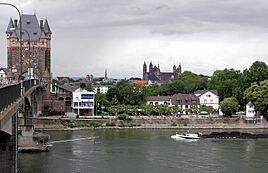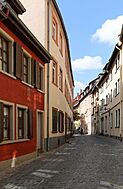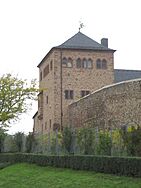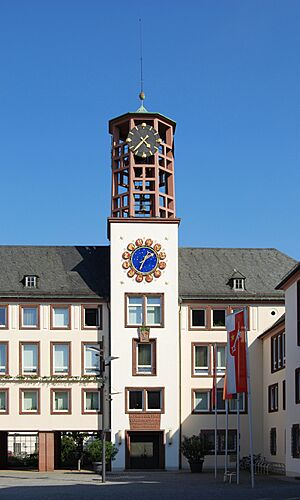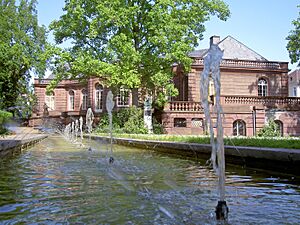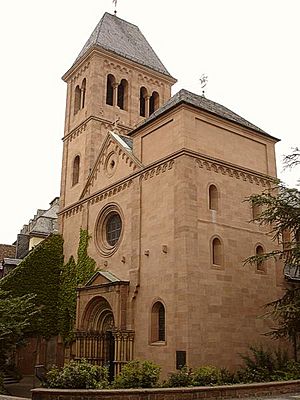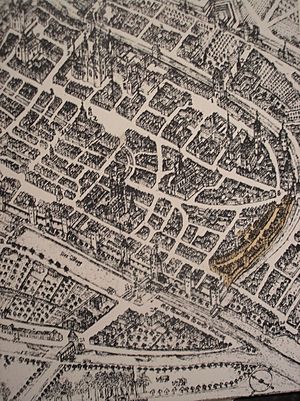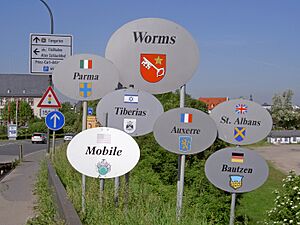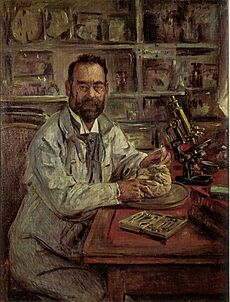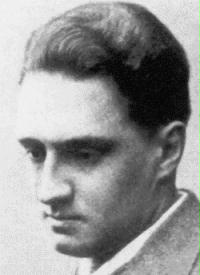Worms, Germany facts for kids
Quick facts for kids
Worms
|
|||
|---|---|---|---|
|
|
|||
|
|||
| Country | Germany | ||
| State | Rhineland-Palatinate | ||
| District | Urban district | ||
| Elevation | 100-167 m (−447.9 ft) | ||
| Population
(2022-12-31)
|
|||
| • Total | 84,646 | ||
| Time zone | CET/CEST (UTC+1/+2) | ||
| Postal codes |
67547–67551
|
||
| Dialling codes | 06241, 06242, 06246, 06247 |
||
| Vehicle registration | WO | ||
| Official name: ShUM Sites of Speyer, Worms and Mainz | |||
| Type: | Cultural | ||
| Criteria: | (ii)(iii)(iv) | ||
| Designated: | 2021 | ||
| Reference #: | [1] | ||
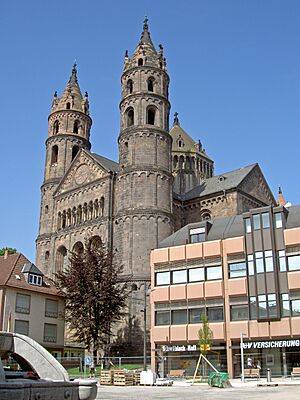
Worms is an old city in Rhineland-Palatinate, Germany. It is located on the Upper Rhine river. About 84,646 people lived there in 2022.
Worms is one of the oldest cities in northern Europe. It was founded even before the Romans arrived. In the early 400s, it was the capital of the Kingdom of the Burgundians. This is why Worms is famous in old legends, like the Nibelungenlied.
The city has been a Roman Catholic bishopric since at least 614 AD. It was also an important place for Charlemagne. The Worms Cathedral is a beautiful example of Romanesque architecture. Worms grew wealthy in the High Middle Ages as an imperial free city.
Many important meetings, called diets, were held in Worms. One famous meeting in 1521, known as the Diet of Worms, declared Martin Luther a heretic. Worms is also one of the historic ShUM-cities. These were important centers for Jewish life in Europe during the Middle Ages. Its Jewish sites, along with those in Speyer and Mainz, became a UNESCO World Heritage Site in 2021.
Today, Worms is a center for industry. It is known for Liebfraumilch wine. Other industries include chemicals, metal goods, and animal feed.
Contents
What's in a Name? The History of Worms' Name
The name Worms comes from an old Celtic word: Borbetomagus. This word meant "settlement in a watery area." Over time, this name changed into the Latin name Vormatia. This Latin name was used from the 6th century onwards.
The name was also kept in Medieval Hebrew as Vermayza. In modern Polish, it is called Wormacja. In English, you say it like "vorms."
Where is Worms Located?
Worms is on the west side of the River Rhine. It is located between the cities of Ludwigshafen and Mainz. Two smaller rivers, the Pfrimm and the Eisbach, flow into the Rhine at the edges of the city.
City Parts: Worms' Boroughs
Worms has 13 different areas, or "boroughs," around its city center. Here are their names and how many people live in them:
| Name | Population | Direction and distance from city centre |
|---|---|---|
| Abenheim | 2,744 | Northwest 10 km (6.2 mi) |
| Heppenheim | 2,073 | Southwest 9 km (5.6 mi) |
| Herrnsheim | 6,368 | North 5 km (3.1 mi) |
| Hochheim | 3,823 | Northwest |
| Horchheim | 4,770 | Southwest 4.5 km (2.8 mi) |
| Ibersheim | 692 | North 13 km (8.1 mi) |
| Leiselheim | 1,983 | West 4 km (2.5 mi) |
| Neuhausen | 10,633 | North |
| Pfeddersheim | 7,414 | West 7 km (4.3 mi) |
| Pfiffligheim | 3,668 | West |
| Rheindürkheim | 3,021 | North 8 km (5.0 mi) |
| Weinsheim | 2,800 | Southwest 4 km (2.5 mi) |
| Wiesoppenheim | 1,796 | Southwest 5.5 km (3.4 mi) |
Weather in Worms
The Rhine Valley has cool winters and very warm summers. It gets less rain than nearby areas. Snow in winter is usually light and melts quickly.
Worms Through Time: A Brief History
Ancient Times: From Celts to Romans
Worms was first a Celtic city called Borbetomagus. This name probably meant "water meadow." Later, a Germanic tribe called the Vangiones took over. In 14 BC, Roman soldiers led by Drusus captured the city. They built a fort there and stationed soldiers.
The Romans tried to rename the city Augusta Vangionum. This name honored the emperor Augustus and the local tribe. However, the old name Borbetomagus stuck. It eventually became the German Worms and the Latin Wormatia.
The Roman fort grew into a small town. It had a regular street plan, a public square (forum), and temples. You can see Roman items like inscriptions, altars, and a large collection of Roman glass in the local museum.
Around 411 AD, a Roman leader named Jovinus made Worms his base. He was helped by King Gunther of the Burgundians. The Burgundians had settled near the Rhine and Moselle rivers. Worms became the capital of their kingdom under King Gunther.
In 436 AD, the Burgundian kingdom was almost completely destroyed. A combined army of Romans and Huns attacked them. This battle was caused by Burgundian raids on Roman towns. The Roman-Hun army defeated the Burgundians at the Battle of Worms. King Gunther was killed. About 20,000 people are said to have died. The remaining Burgundians were moved south to a Roman area called Sapaudia (modern-day Savoy). This war story later inspired the famous Nibelungenlied epic poem.
The Middle Ages: A Center of Power and Faith
The bishopric of Worms was already in place by 614 AD. During the Frankish Empire, Worms was home to an important palace of Charlemagne. The bishops managed the city and its lands. One well-known early medieval bishop was Burchard of Worms. In 868, an important meeting, called a synod, was held in Worms. Around 900 AD, the city walls were rebuilt.
Worms became very successful in the High Middle Ages. In 1074, King Henry IV gave the city special rights. This made Worms an imperial free city, meaning it was mostly self-governing. The bishops lived in Ladenburg and only had power over the Worms Cathedral itself.
In 1122, the Concordat of Worms was signed here. This agreement helped settle a big argument between the Pope and the Holy Roman Emperor. Another important meeting, the imperial diet of 1495, tried to reform the Holy Roman Empire.
The most famous meeting was the Diet of Worms in 1521. Here, Martin Luther refused to change his religious beliefs. Because of this, he was declared a heretic. Worms was also where the first Bibles of the Reformation were printed. This included Martin Luther's German Bible and William Tyndale's first complete English New Testament by 1526.
Jewish Life in Medieval Worms
The Free Imperial City of Worms was a major center for Ashkenazic Judaism in the Middle Ages. The Jewish community started there in the late 900s. Worms' first synagogue was built in 1034.
Sadly, in 1096, about 800 Jewish people were killed by crusaders and local mobs. The Jewish Cemetery in Worms dates from the 11th century. It is thought to be the oldest cemetery still in its original place in Europe. The Rashi Synagogue, built in 1175, is the oldest in Germany. It was carefully rebuilt after being damaged during Kristallnacht.
Many important Jewish scholars and rabbis came from Worms. These include Shlomo Yitzhaki (Rashi), Meir of Rothenburg, and Eleazar of Worms. At a rabbinical meeting in Worms around 1100, Rabbi Gershom ben Judah made a rule against polygamy (having more than one spouse). For hundreds of years, the Jewish Quarter of Worms was a lively center of Jewish life.
Today, Worms has a very small Jewish population. The Jewish community as it once was no longer exists. However, many buildings in the old Jewish Quarter have been restored. They are now preserved as an outdoor museum.
Modern Era: Wars and Rebuilding
In 1689, during the Nine Years' War, French troops attacked Worms. They also attacked nearby cities like Heidelberg and Speyer. The French held Worms for only a few weeks. In 1743, the Treaty of Worms was signed. This created an alliance between Great Britain, Austria, and the Kingdom of Sardinia.
In 1792, French troops occupied the city again during the French Revolutionary Wars. The Bishopric of Worms lost its power in 1801. The city then became part of the First French Empire. In 1815, after the Congress of Vienna, Worms became part of the Grand Duchy of Hesse.
Worms During World War II
In early 1945, during World War II, Allied armies moved into the Rhineland. Worms was a strong German position on the west bank of the Rhine. The city was heavily bombed by the Royal Air Force and the U.S. Army Air Forces. There were two major attacks on February 21 and March 18, 1945.
These attacks caused a lot of damage. About 39% of the city's developed area was destroyed. The RAF attack on February 21 targeted the main railway station and chemical plants. However, it also destroyed large parts of the city center. Bombers dropped 1,100 tons of bombs in minutes. The Worms Cathedral was among the buildings that caught fire.
In these attacks, 239 people died in the first and 141 in the second. About 35,000 people (60% of the population) lost their homes. In total, 6,490 buildings were badly damaged or destroyed.
After the war, the city center was rebuilt. Most of it was built in a modern style. About one-third of Worms' buildings are from before 1950. After the war, Worms became part of the new state of Rhineland-Palatinate. The borough of Rosengarten, on the east bank of the Rhine, became part of Hesse.
Worms Today: Oldest City and New Challenges
Today, Worms competes with Trier and Cologne for the title of "Oldest City in Germany." A multimedia Nibelungenmuseum opened in 2001. A yearly festival in front of the Dom, the Worms Cathedral, tries to bring back the feeling of ancient times.
In 2010, the Worms synagogue was attacked with firebombs. Eight parts of the building were set on fire. A Molotov cocktail was thrown at a window, but no one was hurt. Kurt Beck, the leader of Rhineland-Palatinate, spoke out against the attack. He promised to find those responsible.
What to See in Worms: Main Sights
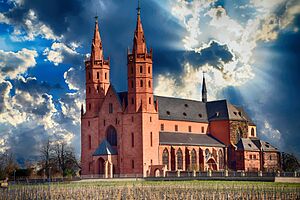
- The Cathedral of St Peter (12th-13th century). It was renovated between 1886 and 1935.
- Reformation Memorial church of the Holy Trinity. This is the city's largest Protestant church (17th century).
- St Paul's Church (Pauluskirche) (13th century).
- St Andrew's Collegiate Church (Andreaskirche) (13th century).
- St Martin's Church (Martinskirche) (13th century).
- Liebfrauenkirche (15th century).
- Luther Monument (Lutherdenkmal) (1868). It was designed by Ernst Rietschel.
- The ShUM city of Worms, a UNESCO World Heritage Site. This includes:
- Rashi Synagogue and Mikvah (a Jewish ritual bath).
- Jewish Museum in the Rashi-House.
- Jewish Cemetery.
- Nibelungen Museum. This museum celebrates the epic poem Das Nibelungenlied (The Song of the Nibelungs).
- Magnuskirche. This is the city's smallest church, possibly from the 8th century.
Worms' Friends Around the World: Sister Cities
Worms has sister city relationships with several places:
 Auxerre, France
Auxerre, France Bautzen, Germany
Bautzen, Germany Mobile, Alabama, United States
Mobile, Alabama, United States Ningde, China
Ningde, China Parma, Italy
Parma, Italy St Albans, England, United Kingdom
St Albans, England, United Kingdom Tiberias, Israel
Tiberias, Israel
Famous People from Worms
- Samuel Adler (1809–1891), a German-American Reform rabbi.
- Curtis Bernhardt (1899–1981), a film director.
- Rolf Wilhelm Brednich (born 1935), a folklorist.
- John Derst (1838–1928), a baker.
- Marvin Dienst (born 1997), a German racing driver.
- Hans Diller (1905–1977), a classical scholar.
- Ferdinand Eberstadt (1808–1888), a textile merchant and mayor of Worms.
- Ludwig Edinger (1855–1918), an anatomist and neurologist.
- Saint Erentrude, or Erentraud (c. 650–710), a virgin saint.
- Hans Folz (1435/1440–1513), a notable medieval author.
- Friedrich Gernsheim (1839–1916), a composer, conductor, and pianist.
- Florian Gerster (born 1949), a politician (SPD).
- Petra Gerster (born 1955), a television journalist.
- Johann Nikolaus Götz (1721–1781), a poet.
- Siegfried Guggenheim (1873–1961), a lawyer and art collector.
- Isaac ben Eliezer, a 15th-century rabbi.
- Isaac ben Eliezer Halevi (died 1070), a French rabbi.
- Heribert of Cologne (c. 970–1021), an archbishop and Chancellor of the Holy Roman Empire.
- Timo Hildebrand (born 1979), a footballer.
- Hanya Holm (1893–1992), a choreographer and dancer.
- Vladimir Kagan (1927–2016), a furniture designer.
- Solomon Loeb (1828–1903), an American banker and philanthropist.
- Meir of Rothenburg (1215–1293), a rabbi and poet.
- Conrad Meit (1480s–1550/1551), a Renaissance sculptor.
- Minna of Worms (died 1096), an influential Jewish citizen.
- Rashi (Shlomo Yitzhaki; 1040–1105), a famous rabbi who studied in Worms.
- Juspa Schammes (1604–1678), a caretaker of the Worms Synagogue and writer.
- Alica Schmidt (born 1998), a track and field athlete.
- Hugo Sinzheimer (1875–1945), a legal scholar.
- Hermann Staudinger (1881–1965), an organic chemist and Nobel Prize winner.
- Rudi Stephan (1887–1915), a composer.
- Monika Stolz (born 1951), a politician (CDU).
- Ida Straus (1849–1912), who stayed with her husband on the RMS Titanic.
- Rod Temperton (1949–2016), an English songwriter and record producer.
- Markus Weinmann (born 1974), an agricultural scientist.
Images for kids
See also
 In Spanish: Worms (Alemania) para niños
In Spanish: Worms (Alemania) para niños


